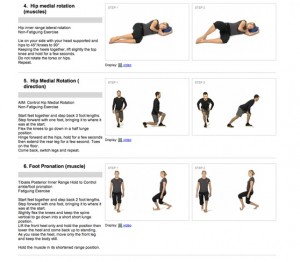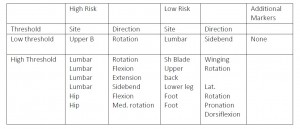Part 3 – Programme Design & Goal Achievement
In part one and part two of this series of articles we discussed how an athletes history of injury can be linked to movement faults identified in their ‘Running Matrix’ screen. Using the case study from part 2 we can see athletic goals and the progression towards correcting movement faults to achieve these goals below:
Background
Goals: To run 10K & ½ Marathon (pain free)
Performance Matrix Screen:
- 1st Score: 40/50 (Nov 2013)
- 2nd Score: 15/50 (10 weeks later)
- 3rd Score: 9/50 (15 weeks later)
The client’s high score make the prioritising process challenging. Their first goal was to run and train pain free and then improve markers of performance. Prior to the first screen he had completed 6 weeks of shockwave treatment to address Achilles & patella tendinopathy issues.
Table 1. The priorities intially targeted
Table 2. Current restrictions & related movement deficits
Programme 1 – 6 exercises.
He is also running 3 times a week (4 km, 6 km and 10 km at weekends) and adhering to a progressive resistance training programme for muscular endurance.
Week 2 – Programme 1 Exercise progressions & restriction management
Within a week progression was added by removing support, taxing balance, employing longer, horizontally aligned levers but ensuring these supplied an asymmetrical challenge to target desired musculature.
Restrictions may make some movement compensations resilient to improvement. This client’s poor lumbar extension control can be associated to his 2 joint hip flexors muscles. These excessively employed structures are also impacting his one joint muscle hip flexion performance. Elongation and control techniques were employed to combat this.
Programme 2 – week 4
By week 4 a new programme is required as progress has been made. Certain priorities have remained as requiring more attention (low threshold foot pronation & lumbar rotation) and there has been the addition of some high threshold work to manage his force production control.
Programme 3
By week 8 there is now a ”down up” approach employed as the emphasis shifts towards addressing more issues around the lower limb. Programme 2 is adapted with this goal in mind.
Retest 15/50 Running Matrix 10 weeks
Results: Table 3
The report reveals the low threshold training has proved highly effective as little remains at high risk. Sidebend and lower leg rotation now targeted as the next focus of low threshold retraining due to influence on running. High threshold concerns focusing around the trunk can be addressed through the use of a muscle specific, control through range method.
Programme 4: Trunk Control Focus– through range exercises with load or speed,


Week 15
Retest 3:
The client achieves an excellent new score of 9/ 50, a total reduction of 31 marks.
The client was running pain free and increasing his distance, adding interval sessions and performing 10K time trials. At this point he did experience a grade 1 biceps femoris tear which reduced training and caused the programme to focus on hamstrings and trunk control exercise. Within 2 weeks he was back to pain free, desired volumes of running in addition to the day to day complaints of knee, back, heel and referred leg pain been reported as minimal or non-existent.
Of course, there is still work to be done as restrictions and movement control issues are still evident but, importantly, he successfully completed two 10km runs (46 mins & 48 mins) and his first half marathon at a time of 1 hour 54 mins.
Summary of case study week by week
Find out more about The Performance Matrix
Get in touch with Andy Hosgood and find out about using The Performance Matrix in your clinic






